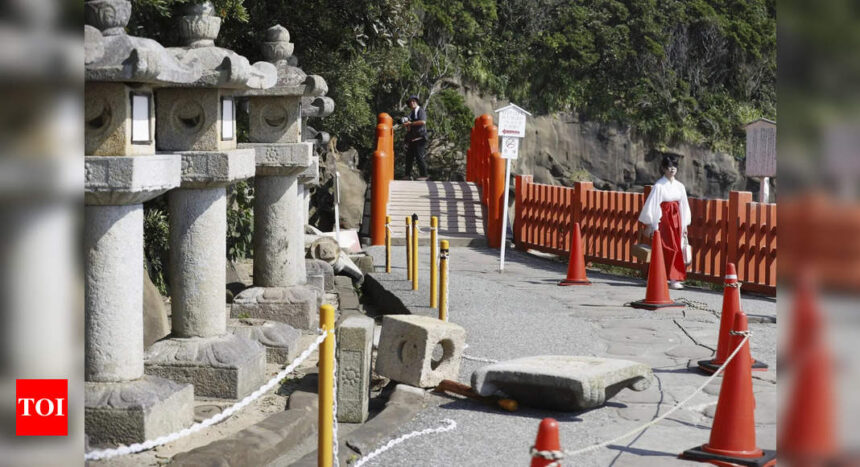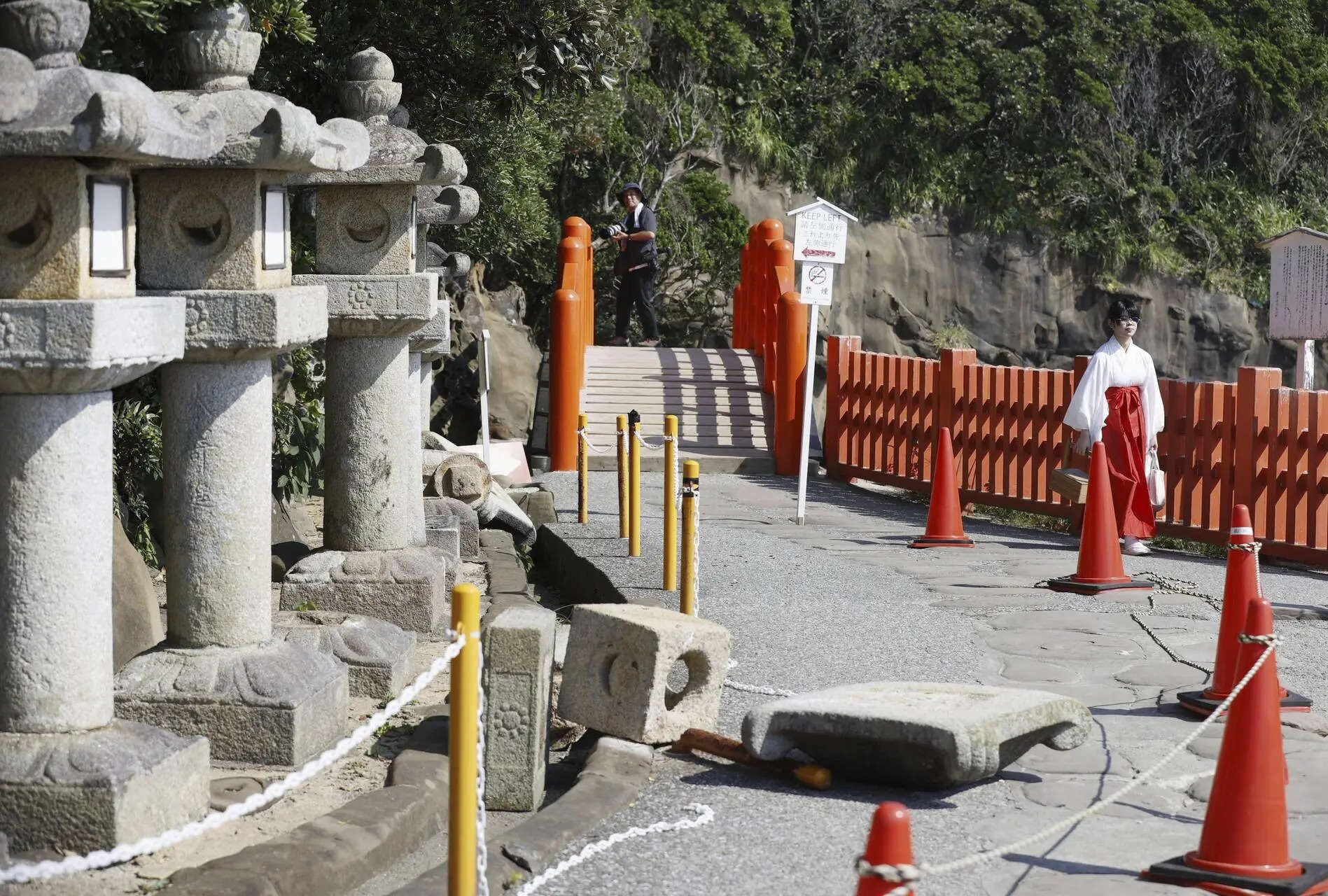[ad_1]
The Japanese government on Thursday announced that it had lifted its warning about a potential “megaquake” that could cause massive destruction and numerous fatalities, with the government advising the public to “go back to normal”.
The week-long warning, which cautioned that a catastrophic earthquake might strike the nation of 125 million inhabitants, led to widespread cancellations of vacation plans and a surge in purchases of essential items, resulting in empty shelves in some stores.
Yoshifumi Matsumura, the disaster management minister, announced the lifting of the advisory at 5.00 pm, stating that: “The people of Japan are free to go back to normal lifestyles.” However, he emphasized the importance of maintaining precautionary measures, such as securing furniture, familiarising family members with evacuation shelter locations, and keeping a supply of emergency food on hand.
Matsumura said: “The special call for attention ended but it doesn’t mean the risk of a major earthquake has been eliminated.”
“We ask (people) to continue to be mindful of these daily precautions and remain vigilant for a megaquake that can happen anytime, anywhere,” he added.
The Japan Meteorological Agency announced on Thursday that the probability of a catastrophic earthquake was “higher than normal” following a 7.1 magnitude quake earlier that day, which resulted in injuries to 15 individuals.
The tremor was classified as a subduction megathrust earthquake, a type that has historically occurred in pairs and has the potential to trigger enormous tsunamis.
What is the Nankai Trough
The warning pertained to the Nankai Trough, situated between two tectonic plates in the Pacific Ocean. The Nankai Trough, situated off the southwest Pacific coast of Japan, is a significant geological feature that extends for roughly 900 km (600 miles). This trough is formed by the subduction of the Philippine Sea Plate beneath the Eurasian Plate.
The convergence of these two tectonic plates along the Nankai Trough results in the accumulation of immense tectonic strains over time. These built-up strains have the potential to trigger a devastating megaquake approximately once every 100 to 150 years, Reuters reported.
In 1707, a rupture spanning the entire 600km length of the Nankai Trough triggered Japan’s second-largest recorded earthquake, followed by the eruption of Mount Fuji. These massive “megathrust” earthquakes typically occur every century or so, often in pairs, with the most recent ones striking in 1944 and 1946.
Trains speed reduced as precautionary measure
According to experts, there is a 70% to 80% probability of a magnitude 8 or 9 earthquake occurring somewhere along the Nankai Trough within the next 30 years.
Experts estimate that such a megaquake could claim up to 300,000 lives and cause damage amounting to $13 trillion, with infrastructure being severely affected.
Despite the potential severity of the situation, experts emphasize that the immediate risk remains low. The agriculture and fisheries ministry issued a statement on Saturday, urging people “to refrain from excessively hoarding goods”in response to the increased demand for emergency supplies such as bottled water, portable toilets, and preserved food, which led to purchase limits in supermarkets and online stores.
The megaquake warning prompted Prime Minister Fumio Kishida to cancel his four-day trip to Central Asia last weekend, opting to remain in the country for the next week to “ensure our preparations and communications are in order,” BBC reported.
As a precautionary measure, some bullet trains have reduced their speed, and authorities have instructed nuclear plants to double-check their disaster preparations to ensure readiness in case of an emergency.
‘Earthquakes at Nankai convincingly scary’
Japan, situated at the convergence of four primary tectonic plates, is subjected to approximately 1,500 earthquakes annually, with the majority being of low magnitude.
Despite the occurrence of more powerful seismic events, the country’s advanced construction methods and well-established emergency protocols typically mitigate the overall impact.
The Japan Meteorological Association warning was the first under new rules drawn up after a 2011 quake, tsunami and nuclear disaster that left around 18,500 people dead or missing.
This recent warning was issued in accordance with updated guidelines implemented following the devastating 2011 catastrophe, which claimed the lives of nearly 18,500 individuals.
According to BBC, Geologists Kyle Bradley and Judith A Hubbard, in their Earthquake Insights newsletter on Thursday, referred to this long-anticipated event as “the original definition of the ‘Big One’”. “The history of great earthquakes at Nankai is convincingly scary” so as to be concerning, the pair acknowledged.
(With inputs from agencies)
The week-long warning, which cautioned that a catastrophic earthquake might strike the nation of 125 million inhabitants, led to widespread cancellations of vacation plans and a surge in purchases of essential items, resulting in empty shelves in some stores.
Yoshifumi Matsumura, the disaster management minister, announced the lifting of the advisory at 5.00 pm, stating that: “The people of Japan are free to go back to normal lifestyles.” However, he emphasized the importance of maintaining precautionary measures, such as securing furniture, familiarising family members with evacuation shelter locations, and keeping a supply of emergency food on hand.
Matsumura said: “The special call for attention ended but it doesn’t mean the risk of a major earthquake has been eliminated.”
“We ask (people) to continue to be mindful of these daily precautions and remain vigilant for a megaquake that can happen anytime, anywhere,” he added.
The Japan Meteorological Agency announced on Thursday that the probability of a catastrophic earthquake was “higher than normal” following a 7.1 magnitude quake earlier that day, which resulted in injuries to 15 individuals.
The tremor was classified as a subduction megathrust earthquake, a type that has historically occurred in pairs and has the potential to trigger enormous tsunamis.
What is the Nankai Trough
The warning pertained to the Nankai Trough, situated between two tectonic plates in the Pacific Ocean. The Nankai Trough, situated off the southwest Pacific coast of Japan, is a significant geological feature that extends for roughly 900 km (600 miles). This trough is formed by the subduction of the Philippine Sea Plate beneath the Eurasian Plate.
The convergence of these two tectonic plates along the Nankai Trough results in the accumulation of immense tectonic strains over time. These built-up strains have the potential to trigger a devastating megaquake approximately once every 100 to 150 years, Reuters reported.
In 1707, a rupture spanning the entire 600km length of the Nankai Trough triggered Japan’s second-largest recorded earthquake, followed by the eruption of Mount Fuji. These massive “megathrust” earthquakes typically occur every century or so, often in pairs, with the most recent ones striking in 1944 and 1946.
Trains speed reduced as precautionary measure
According to experts, there is a 70% to 80% probability of a magnitude 8 or 9 earthquake occurring somewhere along the Nankai Trough within the next 30 years.
Experts estimate that such a megaquake could claim up to 300,000 lives and cause damage amounting to $13 trillion, with infrastructure being severely affected.
Despite the potential severity of the situation, experts emphasize that the immediate risk remains low. The agriculture and fisheries ministry issued a statement on Saturday, urging people “to refrain from excessively hoarding goods”in response to the increased demand for emergency supplies such as bottled water, portable toilets, and preserved food, which led to purchase limits in supermarkets and online stores.
The megaquake warning prompted Prime Minister Fumio Kishida to cancel his four-day trip to Central Asia last weekend, opting to remain in the country for the next week to “ensure our preparations and communications are in order,” BBC reported.
As a precautionary measure, some bullet trains have reduced their speed, and authorities have instructed nuclear plants to double-check their disaster preparations to ensure readiness in case of an emergency.
‘Earthquakes at Nankai convincingly scary’
Japan, situated at the convergence of four primary tectonic plates, is subjected to approximately 1,500 earthquakes annually, with the majority being of low magnitude.
Despite the occurrence of more powerful seismic events, the country’s advanced construction methods and well-established emergency protocols typically mitigate the overall impact.
The Japan Meteorological Association warning was the first under new rules drawn up after a 2011 quake, tsunami and nuclear disaster that left around 18,500 people dead or missing.
This recent warning was issued in accordance with updated guidelines implemented following the devastating 2011 catastrophe, which claimed the lives of nearly 18,500 individuals.
According to BBC, Geologists Kyle Bradley and Judith A Hubbard, in their Earthquake Insights newsletter on Thursday, referred to this long-anticipated event as “the original definition of the ‘Big One’”. “The history of great earthquakes at Nankai is convincingly scary” so as to be concerning, the pair acknowledged.
(With inputs from agencies)
[ad_2]
Source link








